Kharkiv physicists are installing a “reactor of the future”
The preparatory part of a US-Ukrainian nuclear project is over
The preparatory part of the US-Ukrainian project to install a nuclear reactor on the territory of the Kharkiv Physics Technology Institute (KPTI), near Piatykhatky, is over. The decision about US technical assistance in exchange for Ukrainian nuclear material was made as long ago as at the 2010 summit, and the Ukrainian side met its commitments in 2012, which US President Barack Obama announced at the Korea summit. Having received about 70 million dollars from the American side for equipment installation and on-the-site construction, Kharkiv scientists are carrying out their project to create a new-type accelerator-driven subcritical reactor. The institute’s scientific secretary Oleksandr VOLOBUIEV has told The Day some details of this high-profile event.
Mr. Volobuiev, what are the project’s essence and purpose?
“This installation is a precursor of the future safe nuclear engineering. As almost 50 percent of Ukraine’s energy is generated by nuclear power plants, it is difficult to overestimate the importance of this project. Ukraine has not had projects of this level before. It is our design, and one of the designers, Ivan Karnaukhov, is now the project manager. Besides, the device will allow producing a wide range of short-lived radioactive isotopes for nuclear medicine – there will be Kharkiv’s first nuclear medicine laboratory to diagnose and treat cancer-related diseases as part of the science park in a specialized Piatykhatky medical unit.”
What is the current stage of project implementation?
“Both sides have met their commitments to a great extent. All the required contracts have been signed and 95 percent of the equipment has been purchased. We have already finished the construction of a new large building, with state-of-the-art communications and systems, for this reactor. It is planned to bring the facility into action in April 2014. The overall work is under governmental control.”
As the project was being negotiated, the local press wrote about a likely danger to the environment. To what extent are these fears real?
“Although it is a nuclear installation, its thermal power is a mere 250 kW – like that of 250 irons. This project has evoked a negative public response, especially on the part of incompetent people who abused the word ‘nuclear.’ They spoke about an inner-city ‘nuclear facility’ or ‘reactor.’ In reality, work is under the strictest control of state nuclear and ecological inspection bodies. All the specialized organizations have come to positive conclusions, there was a public debate in the spring of 2012, and we fully observe the Ukrainian law.
“I myself live 250 meters away from this installation, and I am calm because it is a subcritical unit, i.e., it has no critical mass of the substance, which rules out a chain reaction, ‘acceleration,’ and explosion, as it happened in Chornobyl. There are sensors on our building’s facade, which show a radiation level of 13 micro roentgens per hour, while there is even a higher level of radiation on the cobblestone of Sumska Street! And, for example, when you are flying on a plane, you are exposed to a radiation of 1,000 micro roentgens.”
Why was the KPTI chosen to carry out this strategic project? What is the institute’s international rating?
“Having a very powerful theoretical background, we have been developing this kind of projects in the past 10-15 years, but there were no investors and funds to implement them. Ukraine is on a high scientific level in this field. We developed this practical-use project together with the US Argonne National Laboratory which designs nuclear installations. We maintained close contact, but we were short of money, and this required a lot of initiative. We gained a practical impetus in 2010, when we got money. Our institute, the KPTI, has been the largest in Ukraine since 1928, nuclear physics being just one of its fields of research. Our associates maintain very close cooperation with 18 developed countries, and we carry out a program of exchange with about 75 organizations. For example, we actively cooperate with Japan in the field of thermonuclear devices. We cooperate with Spain and the French Physics Society. Our theoreticians participate in the Bill Gates-sponsored program to design a reactor of the future. We have designed continuous action devices, such as Uragan stellarators, which are part of our national treasure. Besides, our scientists have made a contribution to designing the famous Large Hadron Collider, which was duly noted at CERN.”






